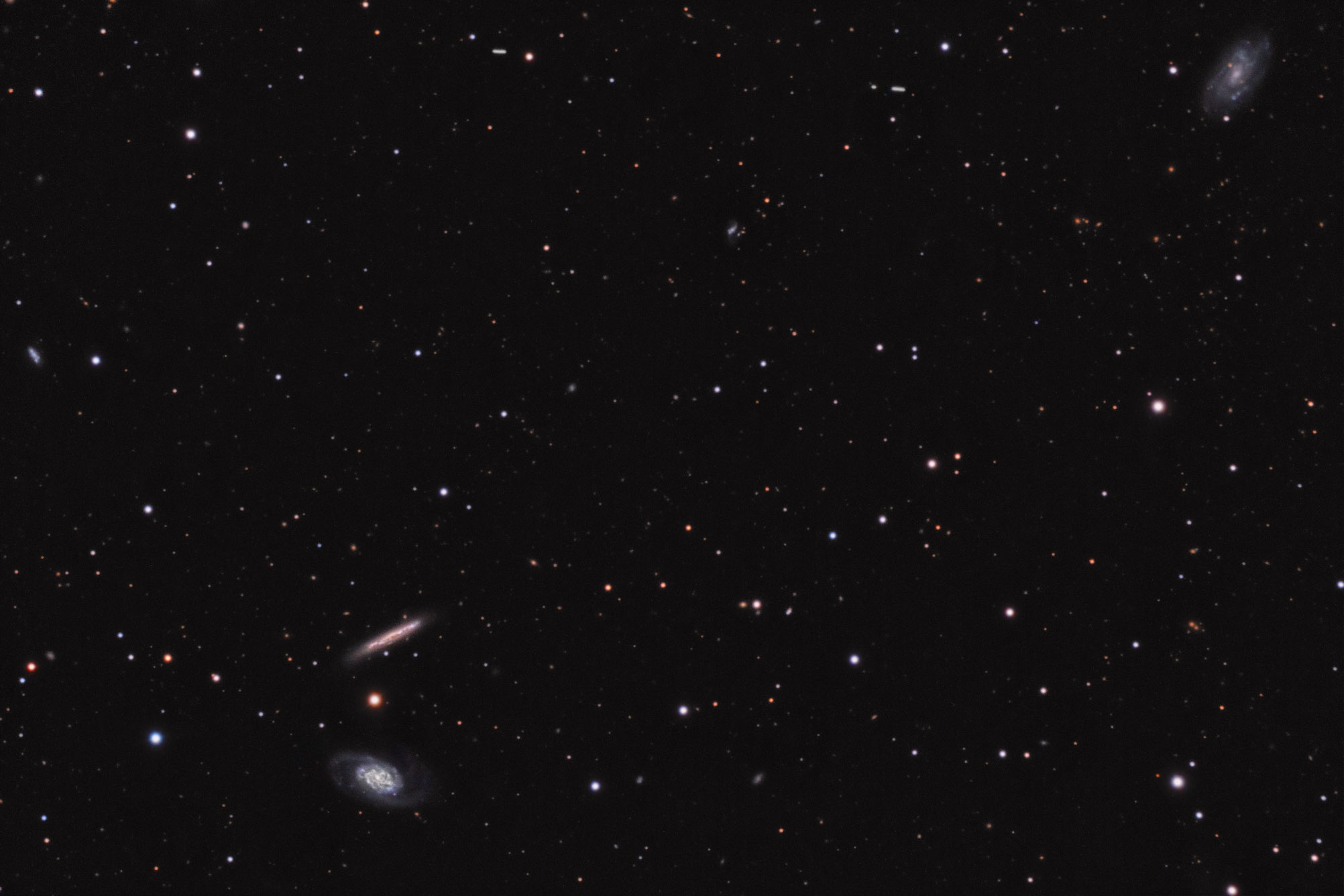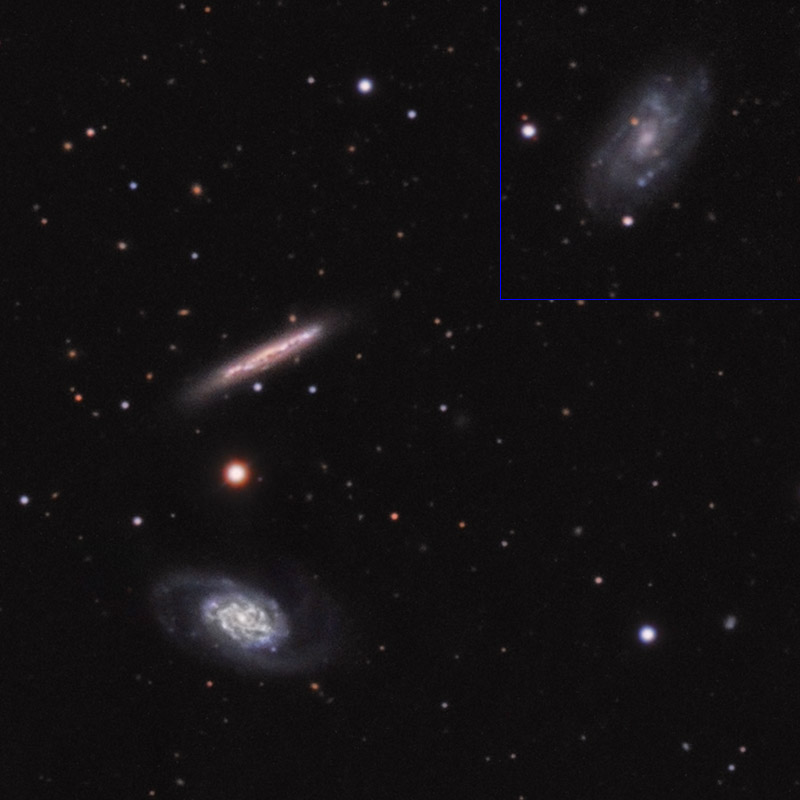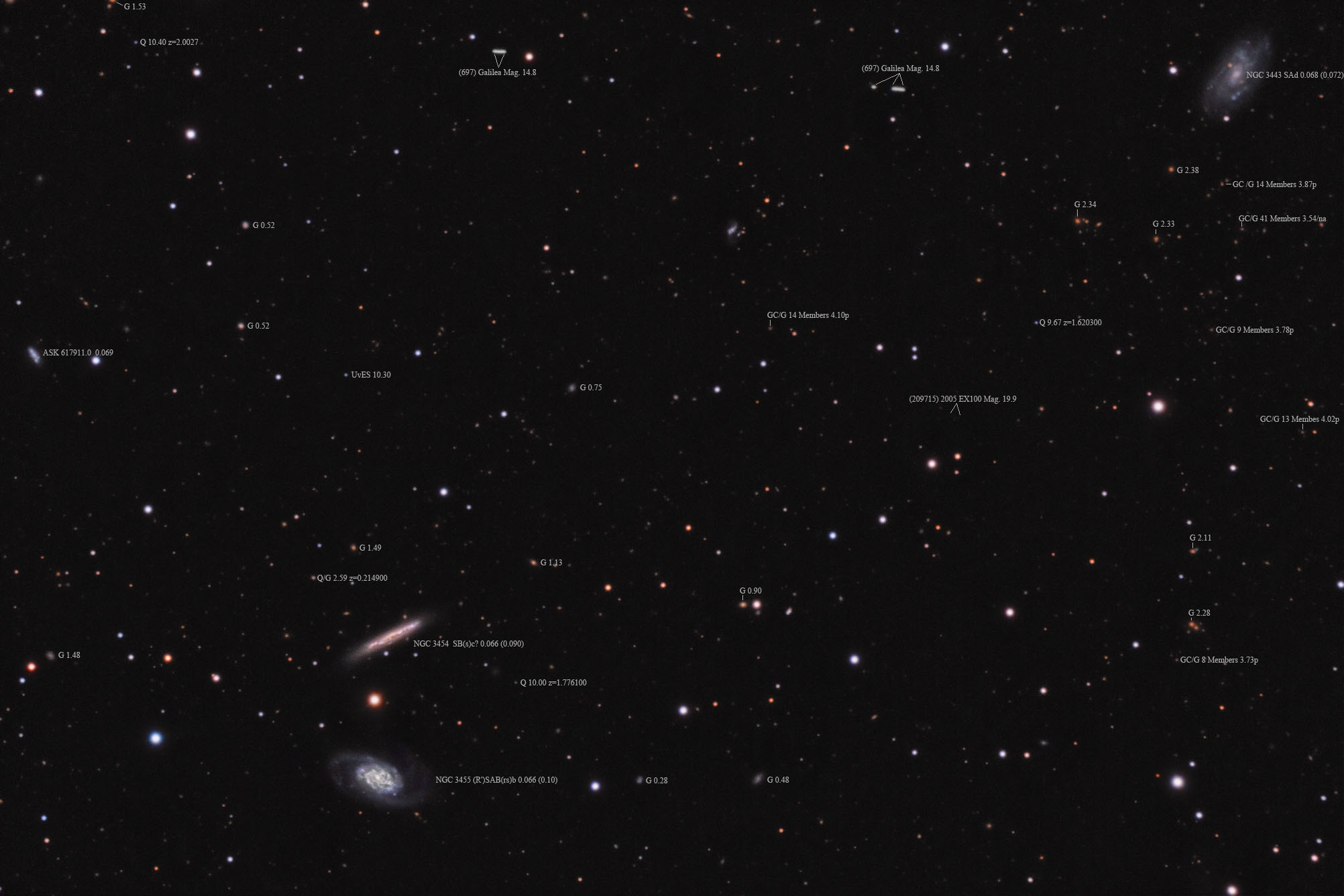Object name: NGC3454Designation(s): NGC3454, NGC3443, NGC3455, NGC 3454 and NGC 3455 are a pair of galaxies in central Leo. Redshift puts them at 66 million light-years distant. Tully Fisher determinations disagree and put them a bit under 100 million light-years away. I think, in this case, the redshift measurements are likely more reasonable. Assuming the redshift distance NGC 3454 and NGC 3455 are both about 52.5 thousand light years across. If the 100 million light-year figure is used then they are about 80 thousand light-years in size. NGC 3454 was found by John Herschel on March 17, 1831. NGC 3455 was found by William Herschel on March 21, 1784.
One note at NED says: "Bright spindle with plume (NGC 3454), disturbed? by UGC 06028 (NGC 3455)..." while another reads: "Bright bar with knots and dark markings. Faint, smooth, outer arms. Edge-on. Non-interacting pair with NGC 3455 at 3.8 arcmin." So are they or are they not interacting? I found no notes on 3455 referencing the apparently distorted outer arms, especially the western one. About all I can see for a plume in 3454 is the southeastern ansa seems puffier than the northwestern one and seems to be off centerline toward 3455. I'd surmise these features aren't unrelated and some interaction has occurred.
I put these off center to pick up NGC 3443 in the upper right corner. Its redshift is insignificantly different from the other two (I found no non-redshift measurements of its distance) so it is likely a member of the same group. Assuming the same distance it is 50,000 light-years in diameter or 76,000 at the 100,000 light-year distance. It is a rather low surface brightness spiral compared to the first two. It was discovered by Lewis Swift on April 24, 1887.
Also, a likely member of the group is ASK 617911.0 on the left edge of the image. Its redshift is similar. It seems to be quite blue with two odd star clouds NE and SW of the core though the SW one is below the major axis of the galaxy. The other small object just above the SW cloud is most likely a nearby star in our galaxy and not a feature of this dwarf galaxy. It is only about 11,000 light-years in diameter at its redshift distance. There's yet a fifth likely member of this group but my framing missed it. It is about one minute of arc above the upper left corner of my image. It is NGC 3457?/NGC 3460. There's some debate over this object's identity. See the NGC Project entries for these two if interested.
North of the center of the image is an oddly distorted spiral galaxy that's small in angular size but rather bright in its core though the outer arms are very faint. NED's only identification of it is SDSS J105353.23+173041.6. Since it didn't have a redshift distance it wasn't labeled in the annotated image.
Due to lousy weather, this one was taken over two consecutive nights. The first night was clouded out after 4 luminance frames. The second night I started again to take the color data but discovered I was taking more luminance instead. I stopped the run and restarted it for color data. By then it was too late to get a complete new object so I decided to take 4 more luminance frames with the time remaining not trusting those I'd gotten the first night. At the time I didn't realize there was a very bright asteroid in the field. Turns out I picked it up both nights. Due to the gap between the first and second luminance frame, it made three trails in the top of the image. The asteroid, discovered by the German astronomer Joseph Helffrich in 1910 and apparently named after the far more famous Italian astronomer Galileo (is Galilea the German spelling of Galileo?) The naming of early asteroids is covered by a copyrighted book so the Minor Planet Center can't give out that information. So this is only a guess on my part. Does anyone have better info?
There's a 20th magnitude asteroid in the image which I show in the annotated version. Since it shows in only 4 (in only the first night's images) of the 9 frames it is nearly invisible in a mean stack of the data though very obvious in the raw data. It barely shows up due to this and the rather poor transparency that first night.
14" LX200R @ f/10, L=9x10' RGB=2x10', STL-11000XM, Paramount ME Related Designation(s):2MASS J10542939+1720384, 2MASS J10542948+1720374, 2MASS J10543110+1717050, 2MASX J10530011+1734250, 2MASX J10542945+1720385, 2MASX J10543106+1717045, 2MASXi J1053001+173425, 2MASXi J1054294+172039, 2MASXi J1054312+171707, 2MFGC 08499, AKARI J1054307+171702, ASK 617943.0, ASK 618752.0, CGCG 095-056, CGCG 095-060, CGCG 095-062, CGCG 1050.3+1750, CGCG 1051.8+1736, CGCG 1051.9+1733, EON J163.623+17.344, FGC 1155, GALEX 2698265349244060756, HDCE 0632 NED002, HDCE 0632 NED003, HOLM 221A, HOLM 221B, IRAS 10518+1733, IRAS F10518+1733, IRAS F10518+1736, KPG 257A, KPG 257B, LDCE 0778 NED012, LDCE 0778 NED013, LGG 219:[G93] 003, LGG 219:[G93] 004, LGG 219:[G93] 005, MAPS-NGP O_432_0333220, MAPS-NGP O_432_0367098, MCG +03-28-025, MCG +03-28-030, MCG +03-28-031, NFGS 070, NGC 3443, NGC 3454, NGC 3455, NGC3443, NGC3454, NGC3455, NSA 138272, NSA 138320, NSA 158969, NVSS J105431+171707, PGC 032671, PGC 032763, PGC 032767, RFGC 1906, RSCG 39:[WBJ2013] A, RSCG 39:[WBJ2013] B, SDSS J105429.52+172038.5, SDSS J105429.53+172038.5, SDSS J105431.08+171705.1, SDSS J105431.09+171705.0, UGC 06000, UGC 06026, UGC 06028, USGC U340 NED09, USGC U340 NED10, USGC U340 NED13, USNO-A2.0 1050-06380485, UZC J105300.2+173426, UZC J105429.4+172038, UZC J105431.1+171704, UZC-CG 124 NED03, UZC-CG 124 NED05, UZC-CG 124 NED06, [BEC2010] HRS 029, [BEC2010] HRS 030, [M98j] 103 NED01, [M98j] 103 NED02, | | 

